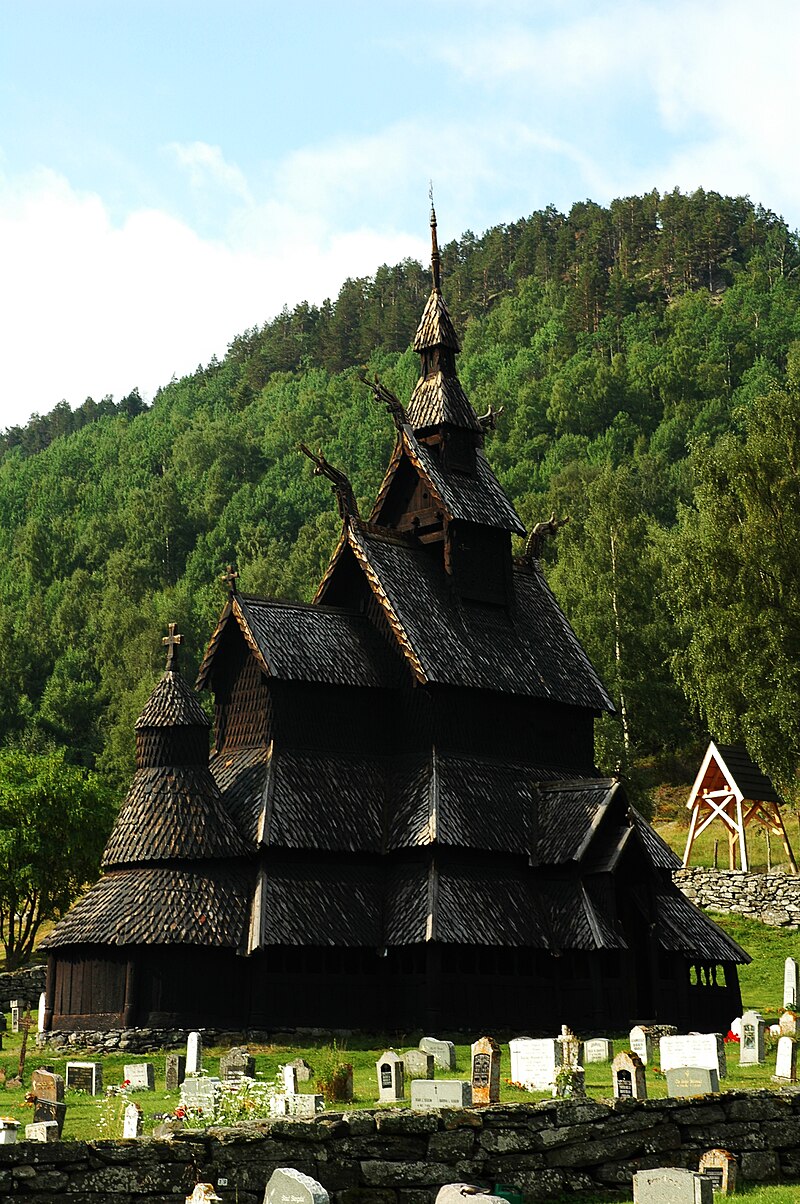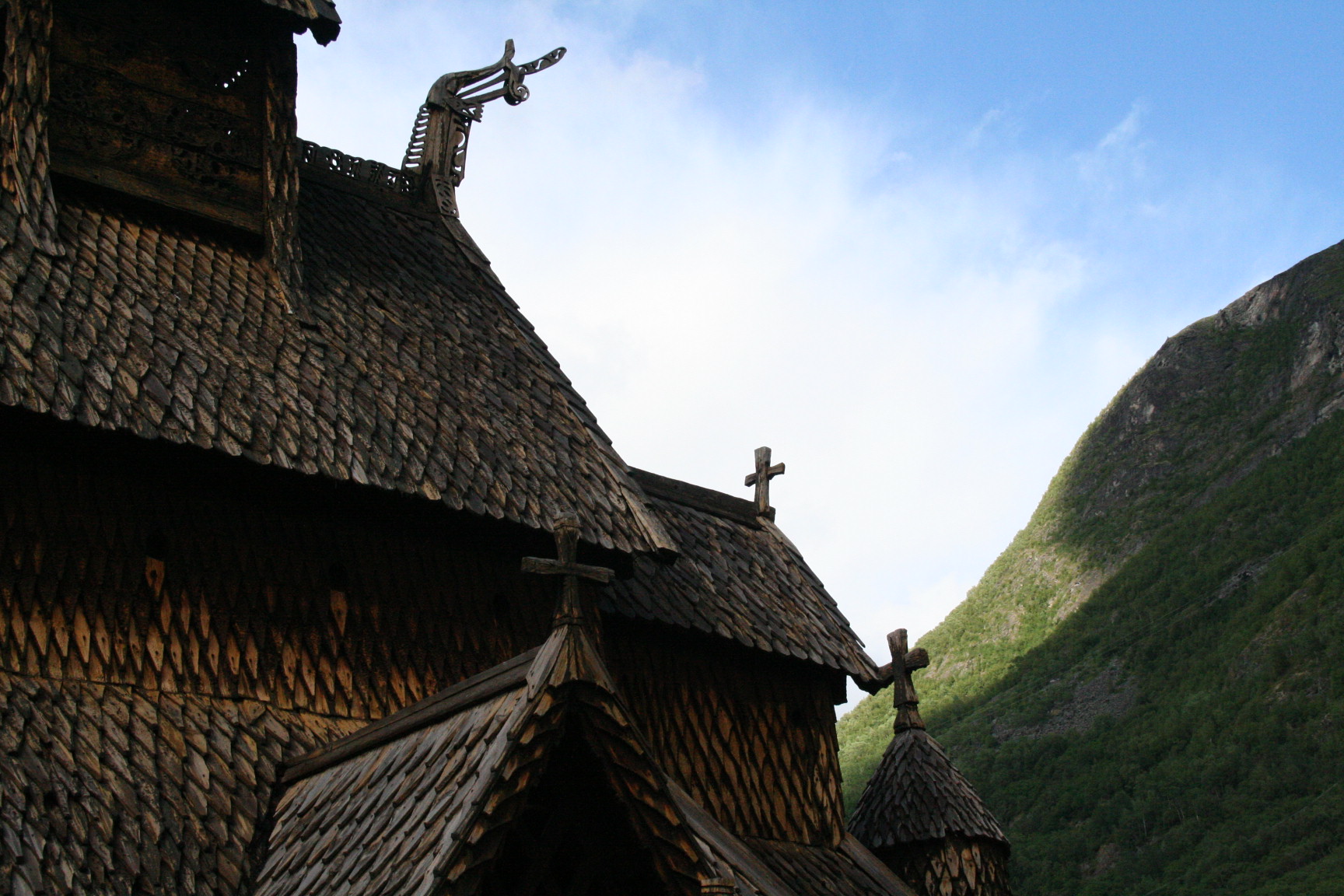At a glance
- Built: c. 1180–1200
- Location: Borgund, Vestland, Norway
- Type: Triple-nave stave church
- Materials: Pine staves, tarred shingles
Norway’s best-preserved stave church (c. 1200) with dragon-head gables and runic carvings
Built between 1180 and 1200 CE, Borgund Stave Church is Norway’s most famous and best-preserved medieval wooden church. Its distinctive silhouette, with tiered roofs and dragon-head finials, has become an icon of Norwegian heritage. Unlike many other stave churches, Borgund has remained remarkably intact thanks to careful conservation and the dry mountain climate of Lærdal.
Architecturally, Borgund is a triple-nave stave church, meaning it has three central aisles supported by massive wooden posts (“staves”). The dark tarred pine shingles covering the steeply pitched roofs protect the church against snow and rain, while creating its almost otherworldly appearance. The interior is dimly lit, with narrow windows, carved portals, and remnants of painted decoration that give a sense of medieval worship.
The west portal is richly decorated with intertwined vines, animal figures, and geometric patterns, showing how Viking artistry was adapted to Christian symbolism. Runic inscriptions carved into the walls include prayers, messages, and even names of medieval visitors — offering a direct link to people who lived here 800 years ago.
Standing next to the old Kongevegen (“King’s Road”), Borgund was an important stop for medieval travelers crossing the mountains between eastern and western Norway. Pilgrims, traders, and kings all passed this way, leaving the church not only as a place of worship but as a landmark in Norwegian cultural history.
Borgund is often described as the “prototype” of stave churches. Architects, historians, and even theme parks have modeled reconstructions on Borgund because it best preserves the original design. Its dragon-head gables recall Viking longships, symbolizing protection against evil spirits, while the Christian cross crowns the spire — a perfect expression of Norway’s cultural transition in the 12th century.
The church is no longer used for regular services but has become a symbol of Norway’s national identity. Each year, thousands of visitors from around the world travel to Lærdal to experience this unique example of medieval Scandinavian craftsmanship.


While Borgund is not individually UNESCO-listed like Urnes, it is part of Norway’s collective heritage efforts recognized by UNESCO for wooden architecture. Conservation began in the 19th century, when stave churches were rapidly disappearing. The Society for the Preservation of Ancient Norwegian Monuments acquired Borgund in 1877, ensuring its survival. Today, it stands as a reference model for scholars studying medieval timber construction.
Borgund’s survival makes it a priceless resource for understanding medieval carpentry, religion, and daily life. Its combination of structural ingenuity and symbolic carvings illustrates how local communities fused Viking traditions with Christianity to create something uniquely Norwegian.
Borgund is in Lærdal, Vestland county, on the scenic route between Oslo and Bergen. Free parking is available at the visitor centre, a short signed walk from the church.
Make the most of your trip by pairing Borgund with the UNESCO-listed Urnes Stave Church, a walk on the Vindhella section of the King’s Road, and nearby fjord viewpoints.
Borgund is located about 30 km from the Lærdal Tunnel, along the historic mountain roads of western Norway. The drive itself is spectacular, with fjord and mountain views along the way. Parking is free at the visitor centre, where you can also see an exhibition on stave churches and medieval life.
Guided tours are available in multiple languages during the summer season. Allow at least an hour to explore both the church and the nearby Kongevegen trail. Combining your visit with Urnes Stave Church, Jotunheimen National Park, or a Sognefjord cruise makes for a rewarding day trip.
For the best photos, late afternoon light emphasizes the textures of the tarred shingles and carved wood. Be sure to check seasonal opening times, as access to the interior is limited during winter months.
Yes. Access is through the visitor centre during the open season from spring to autumn.
No. It is preserved as a protected cultural heritage site rather than an active parish church.
Allow 45–90 minutes to see the church, visit the exhibits, and walk a short stretch of the King’s Road.